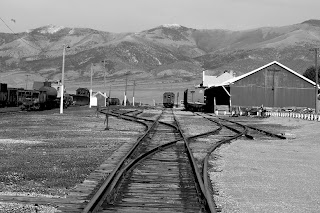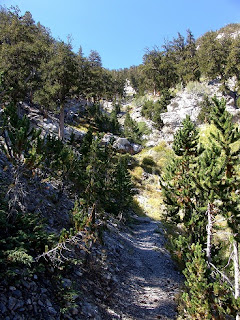Nevada
is known for its lost gold mines and other treasures; so when I heard the story
of the lost treasure that was buried under a large arch on Mt. Charleston, I
knew it was time for another RonnieAdventure!
It
all started when a friend at work told me that his ancestors were pioneers in
the area and his grandfather had known an old lawyer that had a friend who was
a dentist and on dentist’s death bed he told his lawyer friend the story of a
lost treasure on Mt. Charleston. It seems that a number of years before the
dentist died an old prospector had discovered a rich deposit of gold on Mt.
Charleston that was located on the other side of a hidden passage and after filling his knapsack with gold nuggets he started for the
small community of Las Vegas. However, during the trip he encountered a bad
hail storm that dropped so much hail in a few minutes that the hail stones
became knee deep, drifting like snow, and made walking extremely difficult. He
tried to take shelter under a large arch, but the temperature was dropping so
quickly that he could not keep dry and there was no possibility of starting a
fire to get warm. He knew that the only way to survive was to lighten his load
and get to a lower elevation. So, he buried the knapsack full of gold under the
arch and had planned to come back for it at a later time. However, while
descending a steep trail, it was so slippery that he lost his footing and fell
from small cliff into a raging stream. After being washed downstream for about
a mile he somehow managed to pull himself from the stream and then realized
that he had broken both legs and his left arm as he went over a waterfall. He
knew that he needed to get to Las Vegas for medical treatment, so he started to pull
himself down the mountain on his stomach using his one good arm. When a rancher
found him five days later he was near death, but the rancher put him in a buggy
and drove him into Las Vegas where there was a local dentist that also practiced
medicine. There was nothing the dentist could do for the old prospector; but
before the prospector died. he told the dentist where the gold was buried. The
dentist spent the rest of his life searching for the arch and the gold but
could never find them. Then, before the dentist died he told his attorney
friend the location of the arch as told by the prospector. Unfortunately, the
lawyer was too old to go looking for the arch and treasure, so he told my
friend’s grandfather the location. My friend’s grandfather was also too old, so
before he died he told his son where the treasure was buried. Because the son
was very wealthy, he spent
most of his time on his yacht in Hawaii and was not interested in climbing
mountains to look for gold. My friend said that his Father had recently
been attacked by a Great White shark off of the coast of Maui, and wasn’t
expected to survive, so he had decided to quit his job and go to Hawaii to look after his father's estate. After
his Father passed away, he was going to take his Father’s yacht and go to
Australia to live. Since he wouldn’t be around to look for the treasure, he
gave me explicit directions on how to find the arch, and I agreed to cut him in
for half of the proceeds when we sold the gold.
But,
the question was, who could I take along to find the treasure? Then, I
remembered a professor that had just returned from searching for the Caves of
Pythagoras on the island of Samos and was interested in lost treasures. I
called the professor and he said that he had been traveling around the world
all summer and didn’t need the money, but he would use his expertise to help
find the lost arch. I knew we were ready for action when he showed up with his
bullwhip, leather jacket, and felt hat.
After
going over detailed maps and exploring the area from established trails, we
decided on a cross-country route that would lead us directly to the arch. We
had traveled less than 100 feet through the dense forest when we discovered an
old trail that had washed away in many places and was heavily overgrown and being
reclaimed with native vegetation. The trail was difficult to follow and
traveling cross-country was very difficult because the topography was very
steep and the hillsides were covered with broken rock. While trying to navigate
up the broken rock slopes, we kept sliding back about one foot for every two
feet we advanced. After an hour, the muscles in my legs and ankles felt like
they were on fire and I was certain that I wouldn’t be able to finish the
journey. However, the thought of the knapsack full of gold kept me going.
Then,
through a break in the trees, I could see light through the side of large rock
wall. My pulse quickened, my heart started pounding, and I suddenly had a burst
of energy. As I neared the top of the hill I could see the arch plainly, but it
looked small and nothing like the arch in my friend’s story. I took some
pictures and decided to continue up the hill. As I crested the ridge, a
beautiful arch stood before me! And, it looked like Delicate Arch in Utah! This
must be the place! After removing several cubic yards of material from under
the arch, we had not found the gold, but we did substantially enlarge the arch.
Since it was a nice day, we decided to climb to the top of the hill and have
lunch.
After
lunch we started sliding down the hill and were separated as we went around
some large rocks. Then, there it was, a tunnel through the mountain that led
downward at a 45° angle, and I could see light on the other side. Maybe this
was a secret passage that led to some unknown part of the mountain range and
the area where the old prospector discovered the gold nuggets. After lowering
myself down the precarious slope of broken rock, I came out on a ledge about
100 feet above another rock slope. Since we didn’t have any technical climbing
equipment with us, we decided to retreat before one of us fell and got
hurt.
On
the way back to town we started talking about the gold and came to the
conclusion that my friend’s father had probably found the lost knapsack full of gold; sold the gold, and then
made up the story that he had made a lot of money in the stock market. Oh Well, there
is always another lost gold mine to find in Nevada!
In Search of the Lost Arch
First View of Small Arch
Small Arch
The Lost Arch
Arch Enlargement After Material Removal Looking for Gold
Tunnel Arch Leading Downward




































